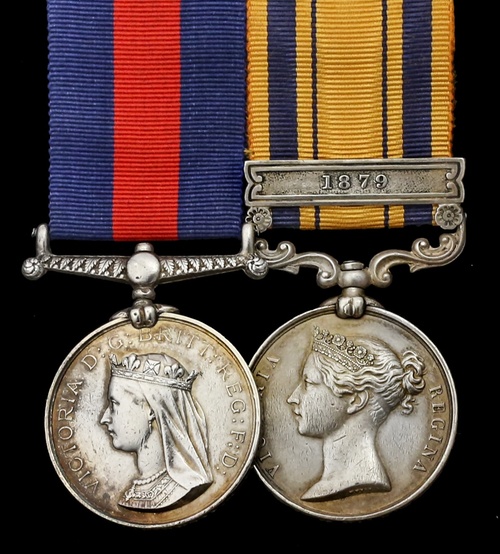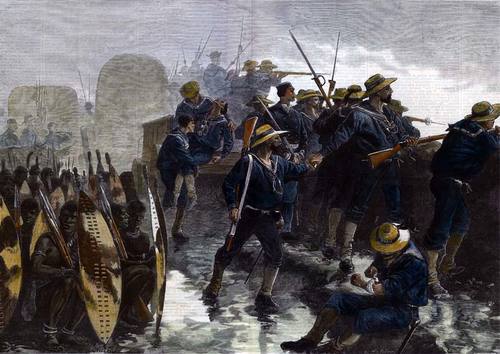Auction: 17001 - Orders, Decorations and Medals
Lot: 173
A rare Waikato War and Zulu War campaign pair awarded to Commander C. Lindsay, Royal Navy, who was mentioned in despatches for his services in the Naval Brigade at the battle of Ginginhlovo in April 1879, when he was 'animated by an excellent spirit'
New Zealand 1845-66, reverse dated 1863-1864 (C. Lindsay, Midn., H.M.S. Esk); South Africa 1877-79, 1 clasp, 1879 (Lieut. C. Lindsay, R.N., H.M.S. Shah), contact wear and somewhat polished, nearly very fine (2)
Charles Lindsay was appointed a Midshipman in H.M.S. Esk in the early 1860s and first witnessed active service in the Waikato War of 1863-64.
As one of 115 crew members to receive the New Zealand Medal with those dates, he must have served in the Naval Brigade or as a member of the Waikato River Flotilla. If the former, he would likely have seen action at the storming of Gate Pa on 29 April 1864, when Esk's contingent suffered losses of four killed and a dozen wounded, including Captain J. C. F. Hamilton, R.N.
Nor was work in the Waikato River Flotilla free of danger, a case in point being the fate of Lieutenant W. E. Mitchell, R.N., also of the Esk: he was mortally wounded in the chest by a volley fired from the east bank of the Waipa River in early February 1864.
Having departed the Esk in October 1867, Lindsay was advanced to Lieutenant in May 1871.
Rebellious Peruvians - trail-blazing 'torpedo expedition'
He next saw action in more unusual circumstances, namely off Peru in May 1877, when he was present at the engagement fought between the armoured frigate Shah - which he had joined in August 1876 - and the Peruvian rebel turret ship Huascar; see Kenneth Douglas-Morris's Naval Medals 1857-1880, for the full story.
The action in question failed to produce the desired result and, on 31 May, Rear-Admiral De Horsey ordered Captain Bedford of the Shah to lay-on a 'torpedo expedition' to finish off the damaged Huascar at her anchorage at Iquique. In so doing, he stated that his preferred choice to lead the attack was Shah's gunnery specialist: Lieutenant Charles Lindsay.
Douglas-Morris takes up the story:
'Lieutenant Lindsay received a more detailed memorandum from his Captain. He was to proceed to the harbour of Iquique as close to land as possible but outside the surf, and on entry find out the position of the Huascar from one of the English merchant ships there. The whaler was to take in tow the Whitehead torpedo and attempt to approach the target from inshore of her. Lieutenant Lindsay was 'most positively' ordered not to project the Whitehead torpedo 'unless certain that it would hit the Huascar direct … at no more than 80 yards distance, with the torpedo set to run not more than 200 yards and then to sink.' These strictures were to ensure that there would not be a disastrous calamity from the Whitehead striking any other vessel.
The pinnace and cutter were to remain hidden in readiness on the seaward side. Only if firing had commenced or upon failure of the inshore torpedo party was the pinnace to attack, 'endeavouring to blow up with her outrigged 100-pound spar charge, taking care that the torpedo is in contact with the ship and, if possible, that engines are working astern at the time.' This mode of attack on an anchored vessel had on occasion been successful during the American Civil War, and in Russian hands against the Turks. The steam pinnace crew would have been well aware that, for success, their attacking craft would need to have physical contact with the Huascar, with the resultant explosion most probably causing the vessel to be swamped. Their Gatling armed cutter as escort was also there to save them!
The boats' crews were to be dressed in white working rig with blue clothing taken with them in the boats. All were to be provided with lifebelts, armed with revolvers, rifles and sword bayonets and silence strictly enjoined. At 5 p.m. on 31 May at some 20 miles off Iquique the Shah stopped and prepared for the torpedo expedition - which set off after dark when within seven miles of the port. Later, the Amethyst came up to Shah making the signal 'Huascar has surrendered today to the Peruvian Fleet,' and fortunately the recall of the expedition by rockets and blue lights was seen by the party when they were within one mile of the target.'
If disappointed that his gallant foray had not quite reached fruition, Lindsay was to be allowed another opportunity to gain the approbation of Their Lordships.
Bluejacket
In March 1879, Shah became the first ship to land Bluejackets following the disaster at Isandhlwana. Among them was Lindsay, who was Senior Lieutenant of the ship's contingent which joined the Etshowe Relief Column.
He was subsequently present at the battle of Ginginhlovo on 2 April 1879, when the officers and ratings of the Naval Brigade manned, two deep, the waist-high rampart behind the shelter trench in Lord Chelmsford's laager, with rocket and Gatling gun detachments posted in the corners. Low's The Great Battles of the British Navy takes up the story:
'In this engagement, which consisted of a gallant attempt by the Zulus to capture the laager in which our troops entrenched themselves on the previous night, a detachment of seaman and marines took a prominent part. The British force consisted of 2,500 Natives and 3,400 Europeans, including the 57th, 3rd Battalion 60th, 91st and some companies of the Buffs and 99th Regiment, and a Naval Brigade drawn from H.M.S. Shah, Tenedos and Boadicea - with 2 guns, 2 Gatlings and 2 rocket-tubes, the seamen being led by Commander Brackenbury, and the marines by Captain Phillips, both of the Shah. The Naval Brigade, with the guns, defended the four angles of the laager, and though the Zulu army, about 12,000 strong, under Dabulamanzi, attacked with their accustomed intrepidity, the fire from the guns and Martini-Henrys was so deadly that they were beaten back and dispersed with a loss of 1,200 men, 470 dead Zulus being buried close to the laager. In this action the British loss was 1 officer and 3 men killed, and 5 officers, including Lieutenant Milne, R.N., and 25 men, including 6 of the Naval Brigade, wounded.'
For his part in the battle that day, Lindsay was mentioned in despatches by Major-General H. Hope Crealock, commanding 1st Division: 'Did good service at Ginginhlovo and was animated by an excellent spirit' (London Gazette 7 November 1879, refers).
Later still, he accompanied Crealock's Column to Port Durnford (Medal & clasp).
Journey's end
Lindsay obtained his first command, the Vigilant, in June 1883, the same month in which he was promoted to Commander. Having then been lent to the Conqueror for the Naval Review of 1887, he joined the Kingfisher on the East Indies Station. This was to be his final seagoing appointment, for he was invalided home in the summer of 1889 and admitted to Haslar Hospital. Subsequently transferred to Yarmouth Hospital, he died on 17 August 1890; sold with copied service record.
Reference sources:
Douglas-Morris, Kenneth, Naval Medals 1857-1880 (Privately published, London, 1994).
Low, Lieutenant Charles R., The Great Battles of The British Navy (George Routledge & Sons Ltd., London, 1872).
Mackinnon, J. P., and Shadbolt, Sydney, The South African Campaign 1879 (J. B. Hayward & Son reprint, London, 1973).
Stowers, Richard, Blue Devils (Privately published, Hamilton, New Zealand, 2008).
Subject to 20% VAT on Buyer’s Premium. For more information please view Terms and Conditions for Buyers.
Sold for
£5,200







